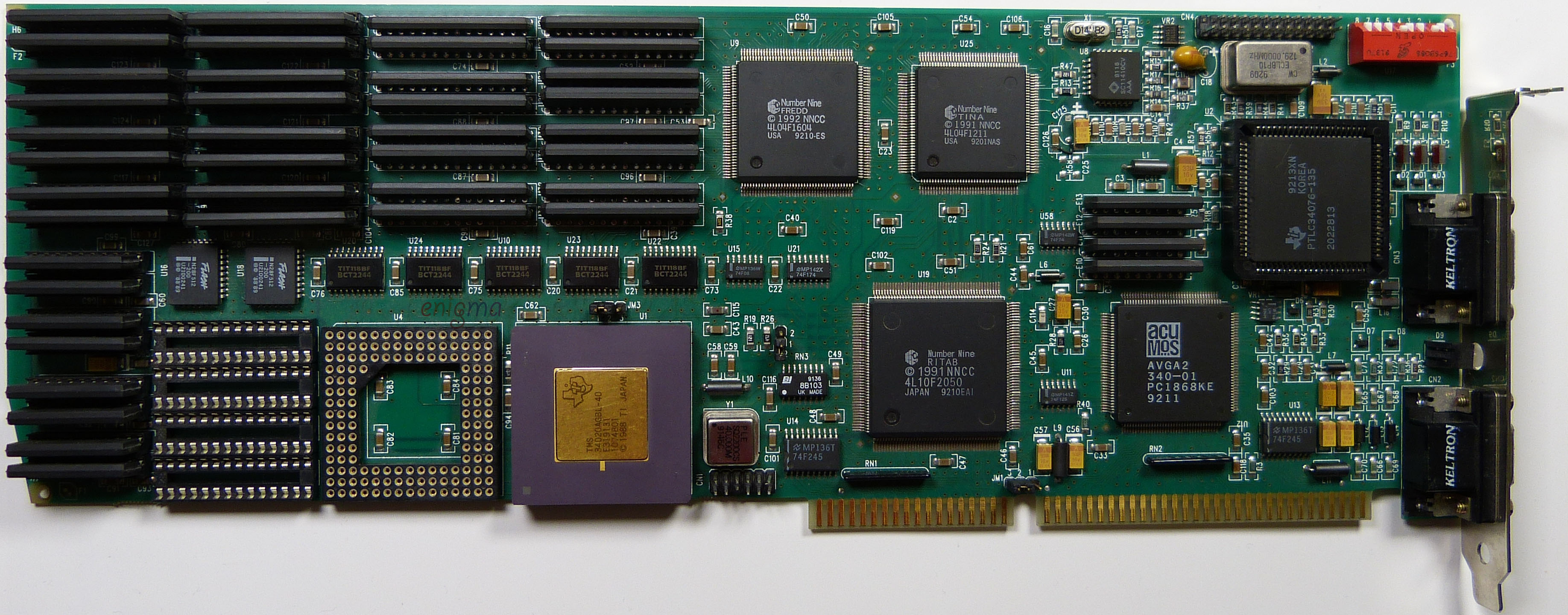Number Nine GXiTC

| Technical details | |
| Name: | GXiTC |
| Company: | Number Nine Computer Corporation |
| Chipset: | Acumos AVGA2, Ti TMS34020ABGL-40 at 40 MHz, Number Nine RITAB, TINA and FREDD |
| Bus: | ISA 16 bit |
| RAM: | 512 kB DRAM for VGA, 4096 kB VRAM TIGA Framebuffer, 1024 kB DRAM Instruction RAM |
| DAC: | Ti PTLC34076-135 135 MHz |
| Connectors: | VGA, VGA |
| PCI-ID: | n/a |
| FCC-ID: | ? |
| Manufactured: | 1992 |
This card is split into a VGA part with Acumos2 chipset / 512 kB RAM (right part) and a graphics solution using TIGA standard (Texas Instruments Graphics Architecture) It consists of a fully programmable 32-Bit TMS34020 graphics processor with 1 MB instruction DRAM and 4 MB own framebuffer VRAM. The RAM is plugged as SIPP on the card. The TMS34020 is able to execute own programs from its RAM and render accelerated 2D graphics into the framebuffer. Small programs for various graphical effects get downloaded as modules to the instruction RAM. The software can run these programs to command the DSP to draw lines/rectangles/ellipses, fill areas, draw text, zoom areas, move sprites...
Theoretically the TMS34020 could address up to 512 MB of RAM.
There is the option to expand the card with a TMS34082 graphics FPU in the free socket with additional instruction DRAM (free SIPP sockets). The TMS34020 has support for multi processor operation where the additional FPU could be used for more complex calculations.
With the TIGA standard it was possible for the first time on PC to show TrueColor graphics. The 4 MB framebuffer of the card enables resolutions of 1024x768 at 16.7 mio. colors or 1280x1024 at 64K colors at 60 Hz refresh rate non-interlaced The card is capable of dual view operation displaying VGA and TIGA output at the same time with the two VGA connectors on the card. For single monitor operation the Ti DAC can pass through the VGA signal.
While Windows 3.x was released a year later the driver allows to run Windows GDI acceleration through the TIGA processor.
With the VESA feature connector it is also possible to use another card for VGA instead of the on board Acumos AVGA2 chipset.
For correct operation when EMM386 or similar is used an exclusion for the mapped memory area has to be added.
This cards serial is 65581
Memory chips on card:
Framebuffer RAM 1MBit Dual-Port DRAM:
M5M442256AL
2322E01 -8
G1
Instruction RAM 256Kx4 DRAM:
MCM514256AZ80
UJJ AC
Acumos VGA RAM 256Kx4 DRAM:
MCM514256AZ80
UJJ BE
Number Nine TIGA dance demo showing a starfield with the NCC-1701 Enterprise flying through the visible area. Also different accelerated graphics features are shown including a accelerated list of text with Beatles song titles. This runs on a 386DX-40 system.
Booting up the 386 to Windows 3.11 using the Number Nine GXiTC in 1280x1024 64k
Running Wintune Bench on the 386 in Windows 3.11 using the Number Nine GXiTC in 1280x1024 64k
Various applications on the 386 in Windows 3.11 using the Number Nine GXiTC in 1280x1024 64k.
Number Nine GXiTC Drivers
Number Nine GXiTC jumpers from Total Hardware 99
Ti DAC datasheet
TMS34020 Datasheet
TMS340 Interface Users Guide
TMS340 Family C Source Debugger Users Guide
TMS34020 Users Guide
Brief introduction into TIGA programming on Geekdot Part I.
Brief introduction into TIGA programming on Geekdot Part II.
Local copy of tiga cube example from Geekdot
TIGA 2.01 Driver Development Kit
TIGA BGI (Borland Graphics Interface) driver by Rolf Bartz
Box Pictures of the GXi Lite from unknown source
